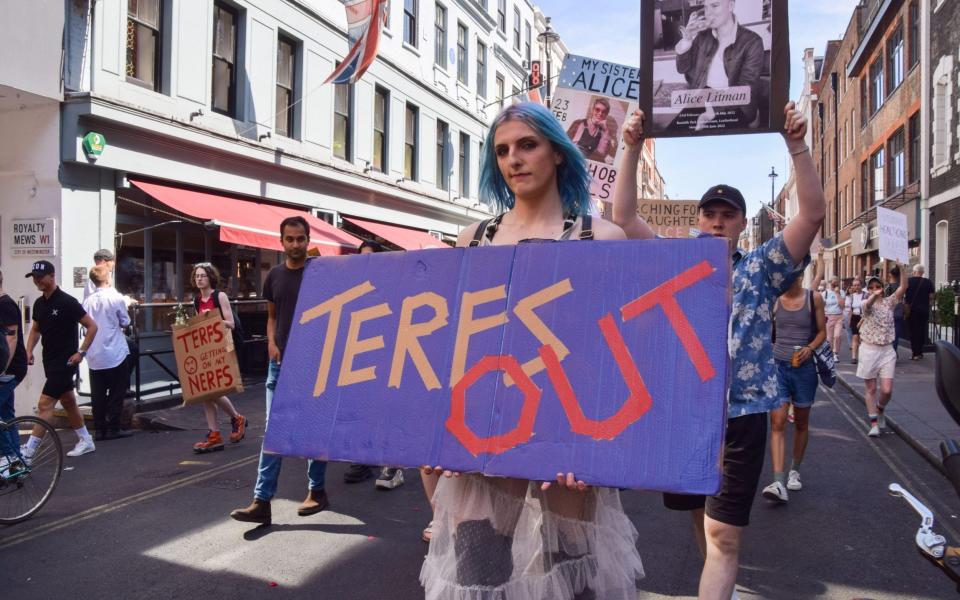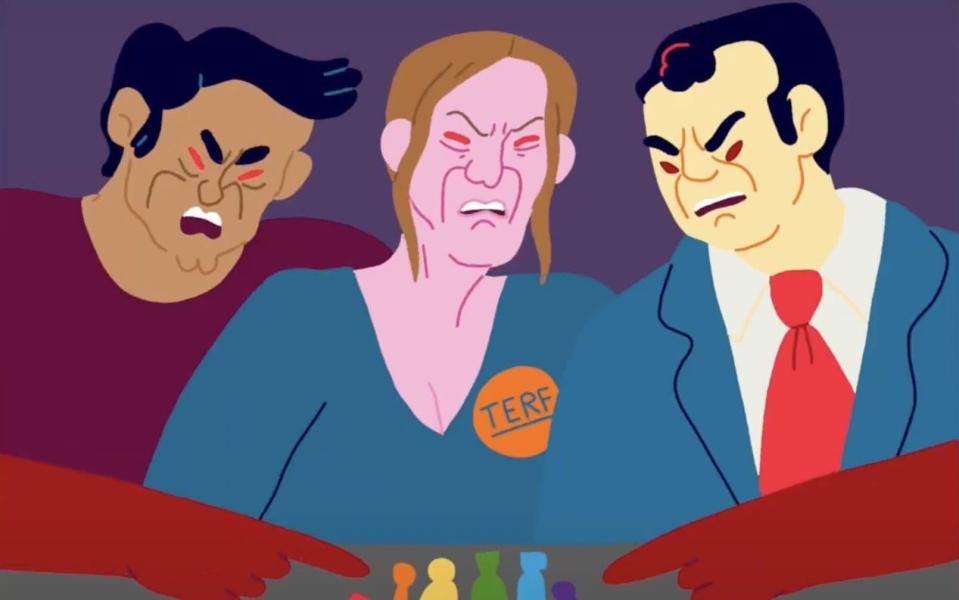‘Terf’ is the ultimate slur against women

Have you ever been called a “terf”?
I think I first was in 2013, and I did not know what it meant. A throwaway line I had written in an essay about female anger – “we are angry with ourselves for not being happier, not being loved properly and not having the ideal body shape – that of a Brazilian transsexual” – got me into lots of trouble.
All I was trying to conjure up was the impossible ideal of slim hips and big breasts that we were seeing on the catwalks that year.
Suddenly I was somehow responsible for the terrible deaths of trans women in Brazil. There is a very high murder rate there and as many of them are involved in prostitution, their lives are precarious.
Looking back, I now see that if anyone throws the term “terf” at you, they invariably accuse you of all sorts of violence, while at the same time making vile threats to you. Terf, which stands for Trans Exclusionary Radical Feminist, is not a neutral term or a description, it is a projection of hatred onto women, and usually older women. It drips with gleeful misogyny.
Oxfam, which one would imagine needs to burnish their image with women, after a series of appalling scandals involving their workers sexually exploiting young girls, in both Chad and Haiti, like all NGOS (non-profit organisations operating independently of any government) is keen to tow the correct line during Pride month. Somehow this has come to mean prioritising the needs of trans people above all others. This resulted in an animated film in which an evil red-eyed woman wears a badge saying TERF. The similarity to an image of JK Rowling was immediately noticed and Oxfam, claiming this was accidental, has gormlessly backtracked. But what were its staff thinking?
Why are terfs an all-purpose enemy for a charity set up to help the poorest and most vulnerable people in the world? Why not picture Ugandan leaders who have just outlawed homosexuality if you want to do something for Pride? But in 2023, terf is the default slur.

The acronym was coined by a feminist blogger named Viv Smythe in 2008. She had witnessed discrimination against transgender women at a feminist music festival in Michigan and wrote about it. When transwomen were turned away by some radical feminists, she came up with the term, as a backlash began against this tiny group of radical feminists. And so the “debates” began.
Jennifer Saul, the Chair of Social and Political Philosophy of Language at the University of Waterloo, states though terf is not meant to be derogatory, “it can be construed that way because the word is typically combined with anger and retaliation”. You’re telling me!
You can buy yourself a Kill The Terf hoodie online. I have been told to “Die terf” and threatened in various ways. Worse, there have been horrible threats of sexual assault to my children.
If you want any idea of what goes down online look at the sites such as “terfisaslur” but be warned, the threats and swearing you’ll find there aren’t pleasant.
Is there any point in saying I am not “trans-exclusionary” or even a particularly radical feminist? Not really. For the record, I don’t believe in some mystical gender identity which is simply a secular version of the soul. I am concerned about the medicalisation of children, and I want to keep our existing rights to single sex spaces, and to stop our language being erased. I fully accept the right of adults to live as they wish and transition if that is what they desire.
This is pretty much what most people think, but terf is another word for bigot or transphobe. The cult-like nature of gender ideology means that the tiniest challenge to it is heresy, there is no debate, just mostly online bullying.

In real life, the bullying is particularly nasty. At Women’s Place Meetings and other events I have attended, masked-up men bang and shout about killing terfs to intimidate us. It is not women who kill trans people. It is men, yet again the violence is all headed our way. It’s almost as if there is a problem with women insisting on our own boundaries, and saying no.
As Dr Jane Clare Jones, feminist philosopher and editor of The Radical Notion tells me, “I think when it is used against women it is always intended as a slur to shut down our speech. Pretty much as soon as it started being used against us for that purpose, some women started reclaiming it, not because we agree with its meaning, but in order to take the edge off it. Which worked. By 2016 or so, it basically had no power over me, as a word. Which isn’t to say the kind of censure of threats it enables and licences didn’t.”
Indeed, terf is always used to end a conversation – never to begin one. And worse. While terfs are accused in hysterical rhetoric of promoting genocide and literal violence, politicians from the SNP are pictured alongside those in Glasgow holding placards saying ‘Decapitate Terfs.’

Last October the women’s officer of Cambridge University Students Union issued a guide on how to spot “terfs”. Who needs a witchfinder general now?
Surely it’s fairly easy to spot a terf? They may look like your Mum, they may lurk on Mumsnet, they are akin to “Karens”, women who complain and always want to see the manager. They are dull and middle aged. In the brilliant book Hags, Victoria Smith tells us “Perhaps they have terf bangs (fringes denoting exclusionary view about gender) or maybe a ‘Karen haircut’, (a bleached bob that is a sure sign of middle-aged entitlement and quite probably racism”. Terfs, you see, with their belief in biology are just not groovy, whereas gender identity is currently fashionable – so many young women may have their doubts about the whole gender shebang, but are terrified of this label and the Scold’s Bridle that goes with it.
As Rebecca Reilly-Cooper, lecturer in political theory at the University of Warwick, says: “The use of the label terf to describe any woman who argues in favour of some female-only space serves to pathologize all disagreement on this issue and to foreclose the possibility of reasoned discussion and compromise”. Saying the penis is a male sex organ for instance is enough to be labelled “a dangerous , transphobic bigot”.
Many feminists now prefer the term Gender Critical though there is a certain amount of reclaiming going on. The hashtag TerfIsland was trending the other day, with many people saying they were pleased to live in a place where critical thinking is still allowed. Groups of self-declared Terven have huge fun together (or so I am told!). Yet for some even terf is too mild, and any dissenters must now be called “anti-trans activists”.
This is all so completely bonkers, and yet it will continue to ramp up as more people wake up to gender madness. Often these days, 20-somethings sidle up to me to confess their terf tendencies. On Twitter, there are lists of “bad women” on Terfblocker, so delicate people never have to encounter us. In 2018, Jeremy Clarkson, Boy George, Alan Shearer and the makers of Pampers Nappies featured on Terfblocker so I am not quite sure how it’s worked out.
Am sure all would reject the label (if they even knew they had received it).
In truth I would be happy never to hear this term again as it is so woman-hating, it is ageist and designed to silence younger women or indeed anyone who wants to speak out. It is idiotic – revealing much about the person or institution using it: chiefly a refusal to think and an inability to listen.
All this anger at women who stand their ground is about more than “trans lives”, it is an attempt to stop women organising. It is an attempt, in the end, at excluding us from participating in discussion about our own rights. And it is doomed. Silly names won’t stop us now.

